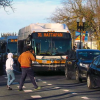Smack in the center of New York City — in the confines of Central Park — there are ghostly vestiges of a 19th century neighborhood that once was vibrant and thriving but now is largely forgotten: Seneca Village.
It is considered by historians to be one of Manhattan's earliest communities of African-American property owners.
This much is known: Between 1825 and the mid-1850s, it was alive. Seneca Village was home to a variety of Americans. Most were of African descent, but there were also Irish and German and maybe some Native Americans, as well. The 1855 state census noted that 264 people lived there. The area had a school, three churches and some cemeteries.
A couple of years later, everyone in the village was told to leave and the neighborhood buildings were razed to clear the way for Central Park. In recent times, historians have begun exploring the village's past.
But for all the present-day records-probing and sites-excavating, there are still many unknowns surrounding Seneca Village.
One of the greatest mysteries: Researchers have not been able to find a single living descendant of anyone who was a resident of Seneca Village.
The Village Today
You can stroll around the area that was once Seneca Village by entering Central Park through Mariners' Gate at 85th Street and Central Park West. The grounds are flanked by playgrounds and, at this time of year, dotted with tulip beds.
The village lay between 82nd and 87th streets, just east of Central Park West.
To trace a path that runs up to Central Park's expansive Great Lawn is to tread among the pines where the frame house and barn of village resident George G. Root once stood — in his time a stone's throw from two more houses, known to belong to Epiphany Davis. Andrew Williams, a free black shoe shiner, purchased three lots of land near there on Sept. 27, 1825.
The area has been examined closely by researchers. Anthropology professors Diana Wall of The City College of New York and Nan Rothschild of Columbia University, and adjunct instructor Cynthia Copeland of New York University, are founding members of the Seneca Village Project, which spearheads the study of the village in an educational context and its commemoration. The project's website offers an interactive map and photos from the site.
Cynthia explains how a number of events in the 1990s colluded to bring the history of Seneca Village to light. In 1991, a 17th and 18th century site of thousands of African burials was uncovered in Lower Manhattan. Now the African Burial Ground National Monument, the discovery at the time spurred people to think about early African presence in New York City's history.
She also credits Roy Rosenzweig and Elizabeth Blackmar, authors of a 1992 publication, The Park and the People: A History of Central Park, for including Seneca Village in their section on pre-park history. The authors used material they found in the New York Historical Society repository, where Cynthia was a curator. In 1997, the historical society mounted an exhibition, "Before Central Park: The Life and Death of Seneca Village," which was called a "piercingly emotional show" by The New York Times.
In 2004, the historians began digging to see what they could find. They continued excavations when funding and time allowed. One focal point was the home of William Godfrey Wilson — a church sexton in the village — complete with vestigial signs of domestic life: pots and pans, a tea kettle and, particularly poignant in the imagining of the past, a child's shoe.
Looking For Descendants
Meanwhile, as the historians were hunting for inanimate representations of the lost village, the Seneca Village Project also began looking for living, breathing people who might have genealogical ties to those long-ago villagers. At the 1997 New York Historical Society exhibit, the names of Seneca Village residents were listed and visitors were asked if they or anyone they knew were related to those original denizens. The anthropologists made a similar query at a series of lectures about Seneca Village given around New York City in the early 2000s. They continue to make appeals whenever possible.
So far, not a single soul has come forward with true knowledge of any inhabitants.
Part of the problem, says Nan Rothschild, is not knowing where residents moved after the village was erased.
Diana Wall wonders if the contentious clearing of the area has shrouded its history in sadness and left a hole in family narratives: "Could it be," she asks, "that because people were evicted from Seneca Village, it was an unhappy part of their past that they chose to forget?"
Both researchers express a wish to dedicate more time to locating the residents, but with courses to teach and other projects, that's difficult. The excavation itself has served as a classroom for over 100 students, Nan estimates, and locating living descendants of the village would be meaningful to all of them.
"It would be nice to package it all up and tie it in a bow. But that's not history ... history is messy," says Cynthia. She remains hopeful about finding descendants of the villagers. "I believe they are out there."
PSA: Anyone who has heard family stories or has other reasons to believe that he or she is a descendant of residents of Seneca Village should contact Cynthia Copeland (ccopelandster@gmail.com), Nan Rothschild (roth@columbia.edu) or Diana Wall (diana.diz.wall@gmail.com).
Daisy Alioto, formerly of NPR, is a news assistant at Law360.
-------------------------------------------------------------------
Copyright 2016 NPR. To see more, visit http://www.npr.org/.



